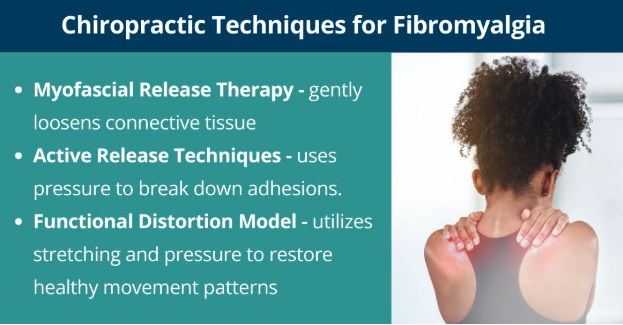
For those living with fibromyalgia, managing daily pain feels like a never-ending battle. The condition doesn’t affect just one part of the body. It causes widespread muscle tenderness, long-term fatigue, and a deep, lingering discomfort that makes even routine tasks feel overwhelming.
To add to the trouble, traditional pain treatments often fall short. This leaves patients searching for something — anything — that can bring lasting relief. Chiropractic care for fibromyalgia is a gentle, non-invasive management option that offers hope to many.
Dr. Jeremy Coffey is a chiropractor at the Western Reserve Hospital Center for Pain Medicine. He specializes in techniques that support the body’s natural healing processes without triggering more pain. Read on to learn what he has to say about chiropractic care for fibromyalgia.
Understanding Fibromyalgia
Fibromyalgia is a chronic condition that causes widespread pain and tenderness throughout the body. The term comes from Latin and Greek roots — “fibro” referring to fibrous tissues like tendons and ligaments, and “myalgia” meaning muscle pain.
Patients with fibromyalgia feel persistent pain and stiffness in muscles, joints, and soft tissues, without visible inflammation or injury.
Dr. Coffey explains, “Fibromyalgia often causes muscle tightness, irritation, and hypersensitivity. Patients experience pain even in areas that shouldn’t be painful.”
The reason for these common symptoms is central sensitization. This is a process where the brain and spinal cord amplify normal pain signals. As a result, even mild pressure or touch feels intensely painful.
This altered pain perception makes everyday activities, such as walking, working, or even resting, more difficult.
Challenges in Treating Fibromyalgia
Fibromyalgia treatment has four important challenges:
- Diagnostic difficulties. Established criteria exist, such as pain involving around 26 trigger points, with at least 18 showing acute sensitivity upon pressure. Still, fibromyalgia is often used as a catch-all diagnosis for widespread musculoskeletal pain when no other clear cause is found.
- Unique pain mechanism. Fibromyalgia pain is not caused by obvious tissue damage or inflammation but rather by an increased sensitivity in the nervous system. It is difficult to pinpoint exactly what is causing the pain.
- Limited medication efficacy. Many pain-reducing medications lack specificity for fibromyalgia and do not work equally well for all patients. Surgical treatments are not applicable at all in treating this condition.
- Treatment paradox. As Dr. Coffey explains, the goal of fibromyalgia treatment is to loosen the muscles and restore function. However, this requires working on specific areas that may already be tender and painful for the patient.
How Chiropractic Care Can Help With Fibromyalgia
Chiropractic care is a gentle, non-invasive holistic approach to managing fibromyalgia symptoms. It focuses on restoring balance and movement within the musculoskeletal system, particularly the spine and surrounding soft tissues.
Benefits of chiropractic care for chronic pain conditions include:
- Reduced muscle tightness and pain, leading to better life and sleep quality
- Improved spinal mobility and overall function
- Better nervous system health and communication
“If we can reduce tightness, irritation, and adhesions in the fascia and tissue,” Dr. Coffey notes, “fibromyalgia patients experience better function and quality of life.”
Chiropractic care is adaptable to each patient’s sensitivity. This makes it a suitable option for those who do not respond well to medications or prefer non-medicine, natural treatments for fibromyalgia.
Most Effective Chiropractic Techniques for Fibromyalgia

Traditional spinal adjustments are not ideal for fibromyalgia patients due to their hypersensitivity. Instead, softer, tissue-targeted approaches are used.
Dr. Coffey explains that soft tissue therapies such as myofascial release and active release technique (ART) are more beneficial. That’s because they focus on the muscles and connective tissues — the areas where patients tend to experience the most discomfort. Here are more details:
Myofascial Release Therapy
Myofascial release for fibromyalgia gently loosens the fascia, a layer of connective tissue that surrounds and supports your muscles. In people with fibromyalgia, the fascia becomes tight and restricted.
Chiropractors release these tight areas through slow, sustained pressure and careful manipulation.
Unlike massage, which feels more rhythmic, myofascial release focuses on “melting” the tension in deeper layers of tissue. It allows muscles to move more freely and reduces the pain caused by tight fascia pulling on sensitive nerves.
Active Release Technique
ART is a hands-on therapy that targets areas where muscles, tendons, and ligaments have developed adhesions. Adhesions are tiny knots or scar-like tissue that limit movement and cause pain.
During an ART session, a chiropractor applies gentle pressure while guiding you through specific movements. It breaks down adhesions and restores normal motion in the affected tissues, leading to immediate improvements in comfort and range of motion.
Functional Distortion Model
The functional distortion model (FDM) views pain as a result of specific soft tissue distortions. These are changes in how your body moves and how your muscles interact with one another.
Chiropractors trained in FDM learn to read your symptoms (and even how you point to your pain) to identify the type of distortion that may be present.They then apply manual techniques involving
stretching, compression, or directional pressure to “reshape” these distortions and restore healthy movement patterns.
Modifying Chiropractic Adjustments for Fibromyalgia Patients
One of the biggest challenges in treating fibromyalgia is hypersensitivity. Even light pressure on certain areas can trigger significant pain. That’s why, when it comes to fibromyalgia and chiropractic adjustments, Dr. Coffey prefers to use techniques that help desensitize the body over time.
According to Dr. Coffey, treatment should begin with the lightest touch possible to allow the patient’s nervous system to acclimate. As tolerance builds, the pressure can be increased gradually.
A helpful chiropractic care technique involves adjusting the size of the contact point. “Think of a pin versus a pencil — wider contact is less painful,” Dr. Coffey explains.
A narrow point of pressure (like a pin) tends to be more painful, while a broader contact (like a pencil) spreads the force and reduces discomfort. Such an approach allows clinicians to work on sensitive areas with less irritation.
Also, each fibromyalgia patient presents differently. Dr. Coffey emphasizes the importance of tailoring each session to the patient’s current pain level and response to fibromyalgia muscle pain treatment.
The Role of Spinal Health in Fibromyalgia Pain Relief
Although fibromyalgia is mainly a soft tissue condition, it is connected to spine health.
“When the spine moves properly, the muscles also tend to move properly,” Dr. Coffey says. “Good spinal mobility helps the nervous system and muscles function correctly, which can reduce widespread pain and other fibromyalgia-related issues.”
In contrast, poor spinal alignment leads to increased muscle tension, stiffness, and postural imbalances. These issues place additional strain on already sensitive areas and worsen fibromyalgia symptoms.
When joints are restricted or misaligned, they interfere with proper nerve signaling. This worsens hypersensitivity and contributes to the widespread pain associated with fibromyalgia.
Combining Chiropractic Care With Other Fibromyalgia Treatments
Chiropractic care is most effective when used as part of a comprehensive treatment plan for fibromyalgia.
According to Dr. Coffey, chiropractic care is a mechanical treatment, much like physical therapy and massage. These therapies work well together. Chiropractic adjustments improve joint movement and reduce muscle spasms, while physical therapy builds strength and flexibility.
Here are some treatment options that can be combined with chiropractic care:
- Physical therapy (PT). It improves strength and endurance, which are reduced in fibromyalgia patients due to long-term pain and inactivity. Chiropractic adjustments improve joint mobility and make it easier for patients to regain strength.
- Massage therapy. Massage reduces muscle tension, increases circulation, and promotes relaxation. Both massage and chiropractic therapies work on the soft tissues but from different angles. Chiropractic care focuses more on mechanics, while massage enhances tissue quality and relaxation.
- Pain medications. While medications do not cure fibromyalgia, they reduce pain, fatigue, and sleep disturbances. Chiropractic care addresses the mechanical aspect of pain, while medications work on a chemical level to reduce symptoms.
Lifestyle Changes To Support Fibromyalgia Treatment
Lifestyle adjustments are essential factors in managing fibromyalgia.
One of the biggest misconceptions about fibromyalgia is that rest is the best remedy. In reality, movement is essential in managing chronic pain, and chiropractic care complements it by improving joint mobility.
When the body remains still for long periods, circulation slows, and muscles tighten, leading to increased discomfort. Regular physical activity, even in small amounts, improves blood flow and promotes natural pain-relieving endorphins.
Movement also improves nervous system regulation. Light activity helps the nervous system “retrain” its response to stimuli, which makes pain easier to manage.
Some recommended exercises for fibromyalgia patients include:
- Walking — low-impact and easy to start at any fitness level
- Swimming or water aerobics — gentle on joints and muscles, with built-in resistance
- Yoga and stretching — promote flexibility, relaxation, and balance
- Chair yoga — a modified version of yoga for those with limited mobility or during pain flares.

As Dr. Coffey advises, even small movements, like standing up, stretching, or doing a light exercise during TV commercial breaks, can add movement to daily life.
Posture and Daily Habits To Reduce Fibromyalgia Discomfort
Good posture supports the natural alignment of the spine and reduces unnecessary strain on muscles and joints. Poor posture — such as slouching or leaning forward for extended periods — contributes to muscle tightness and pain flare-ups.
Remaining in one position for too long, especially sitting, can also cause muscles to become stiff and circulation to slow down.
According to Dr. Coffey, simple daily habits, like maintaining good posture and avoiding prolonged sitting, help improve fibromyalgia symptoms.
Here are some tips to break sedentary patterns:
- Set a reminder to stand, stretch, or walk every 30 to 60 minutes.
- Use a standing desk or alternate between sitting and standing during work.
- Do light stretching or mobility exercises during TV shows or work breaks.
- Adjust your sitting position frequently to prevent stiffness.
Why Choose Western Reserve Hospital for Fibromyalgia Management
Chiropractic care for fibromyalgia does not cure the condition, but it provides a natural path to pain relief and improved mobility.
At Western Reserve Hospital, Dr. Jeremy Coffey brings a unique blend of expertise in sports medicine and pain management to his chiropractic practice.
He collaborates with a multidisciplinary team, including physical therapists, physicians, and other specialists, to develop customized treatment plans that address each patient’s unique needs.
By choosing Western Reserve Hospital, you can trust you’re receiving thoughtful, expert care rooted in compassion and long-term healing. Book an appointment now.
FAQs
Can Chiropractic Care Cure Fibromyalgia?
No, but it can significantly reduce symptoms by improving spinal function, reducing muscle tightness, and boosting mobility.
Is Chiropractic Treatment Safe for Fibromyalgia Patients?
Yes, chiropractic treatments are safe. However, adjustments should be modified to account for pain sensitivity and hypersensitivity. Techniques like myofascial release and ART are often the best approach.
How Often Should a Fibromyalgia Patient See a Chiropractor?
It depends on severity, but many patients benefit from weekly or bi-weekly sessions to manage symptoms.
